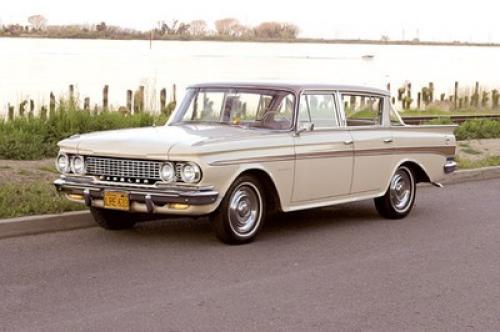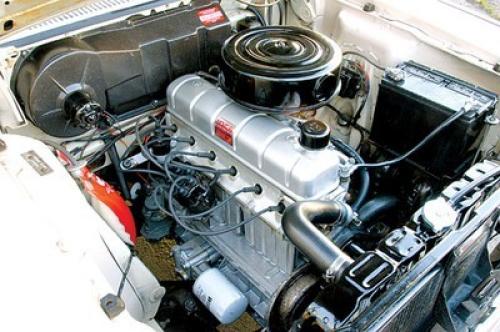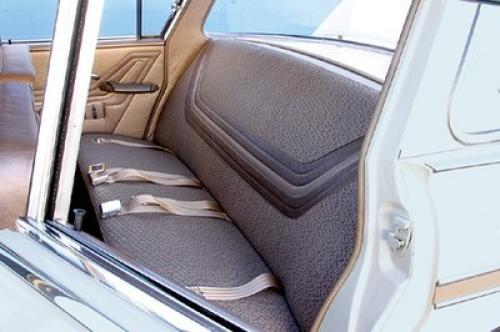FEATURE ARTICLE from Hemmings Classic Car
1961-1962 American Motors Rambler Classic Custom Six
Order Backissues of Hemmings Classic Car Here.
 Hemmings Classic Car - AUGUST 1, 2005
Hemmings Classic Car - AUGUST 1, 2005
Although American Motors technically dissolved in mid 1987, the
love affair with AMC's automobiles is stronger than ever. They designed
and built some of the most fuel efficient, best-styled and well-made
cars of the 1950s & 1960s. If you're a baby boomer, you remember well
all those cute little Ramblers running around town, or may- be your
parents had one of those station wagons with the fold-down seat. Long
admired for their simplicity, utilitarian design approach and servicing
ease, Ramblers of the early 1960s are an inexpensive way to get into
the collector-car hobby, and there are numerous parts outlets and
support to keep your car on the road.
Although the 1961 Rambler was based on the 1956 Rambler body, it
was renamed the Rambler Classic and received a new front end featuring
a one-piece, rectangular extruded-aluminum grille with the letters
RAMBLER underneath. There were several series of the Rambler Classic
Six, including the Deluxe Line, the Super Line and the Custom Line,
which featured bucket seats in a four-door sedan. Pricing started at
$2,098 for the four-door six-passenger sedan. A station wagon cost just
$339 more.
In 1962, the Rambler had no major
changes. The Super models were dropped and replaced by a "400" that had
an overhead-valve engine. A new assembly plant was built in Brampton,
Ontario, Canada, for the production of Americans and Classics. AMC took
a leadership role with their safer brake systems when they fitted all
their cars with dual-circuit master cylinders, something GM didn't do
for another five years. And according to Brian Yacino, national
president of the American Motors Corporation Rambler Club, Rambler
received an award from the Florida Chiropractic Association for
"pioneering in the development of postural seat design."
Engines
There were several engines available.
The base engine was the 195.6-cu.in. straight-six with 127 horsepower.
With its aluminum block, it was quite ahead of its time.
 The aluminum engine came standard in the 1961 Super and 1962 400
models and the cast-iron engine was standard on the Custom and Deluxe
both years, with aluminum optional. The 250-cu.in. V-8 was available
only in the 1961 Classic Eight, model 6120 only. Despite the company's
claims, Ramblers, with six years of design experience and more than two
million test miles on proving grounds, highway and track, were not
infallible, and there were some problems with the aluminum
construction. The die-cast block weighed only 60 pounds, an 80- pound
savings over a cast-iron block. AMC said a precision, high-pressure
die-casting process assured uniformity and high quality with
centrifugally cast-iron cylinder liners that were mechanically and
chemically bonded permanently to the aluminum block. The cylinder head
was cast iron, and the connecting rod bearings were steel-backed
copper-lead alloy for long life. The crankshaft, a drop-forged steel
design, rode in four main bearings. With its 8.7:1 compression ratio,
it produced 180-lbs.ft. of torque at 1,600 rpm. A 138hp version was
also available.
The aluminum engine came standard in the 1961 Super and 1962 400
models and the cast-iron engine was standard on the Custom and Deluxe
both years, with aluminum optional. The 250-cu.in. V-8 was available
only in the 1961 Classic Eight, model 6120 only. Despite the company's
claims, Ramblers, with six years of design experience and more than two
million test miles on proving grounds, highway and track, were not
infallible, and there were some problems with the aluminum
construction. The die-cast block weighed only 60 pounds, an 80- pound
savings over a cast-iron block. AMC said a precision, high-pressure
die-casting process assured uniformity and high quality with
centrifugally cast-iron cylinder liners that were mechanically and
chemically bonded permanently to the aluminum block. The cylinder head
was cast iron, and the connecting rod bearings were steel-backed
copper-lead alloy for long life. The crankshaft, a drop-forged steel
design, rode in four main bearings. With its 8.7:1 compression ratio,
it produced 180-lbs.ft. of torque at 1,600 rpm. A 138hp version was
also available.
Another optional engine was the 250-cu.in. V-8, which was available
in two horsepower versions: 200hp and 215hp, available only in the 1961
Classic Eight. The standard 200hp version featured a Holley two-barrel
carburetor, while the 215hp V-8 had a four-barrel Holley and dual
exhausts. Both V-8s used solid lifters, five main bearings, a
throw-away full-flow oil filter and heavy-duty cellulose-fiber air
filter. They also had an 8.7:1 compression ratio, so regular leaded
gasoline could be used. Speaking of gasoline, Ramblers were stingy with
a gallon of gas in the late 1950s and early 1960s when it really didn't
matter; a Rambler got more than 33 miles per gallon on a trip from
Canada to Mexico during the NASCAR Economy Run in the late 1950s. Cars
destined for California had a special crankcase ventilation system to
comply with air pollution requirements.
Except for reliability problems with the aluminum blocks, the
cast-iron engines are durable and were as strong as anything Chevrolet,
Ford or Chrysler was building. Longtime AMC mechanic Warren Patterson
of Harrisville, Rhode Island, said the problem with the aluminum-block
engines generally surfaced when the owner drove only short distances.
"They had a tendency to get severe carbon buildup," said Patterson, who
worked as a dealer mechanic from 1958 through 1966. "We had a customer
who commuted daily to New York City and was driving 40,000 miles a year
with an aluminum block in his car. He told me it was the best car he
ever owned." Patterson said the V-8s were virtually bulletproof. "If
the customer brought them in for regular service, we had no trouble at
all with those V-8s. A great, great engine."
Transmissions
The standard transmission was a
three-speed manual that was full synchromesh and proved durable and
quiet. The three-speed came with mechanical shift linkage, and AMC had
oil holes added to the main drive gear on the Classic Six transmission
to improve lubrication. Parts are readily available to rebuild these
units. The manual transmission came with a dry-disc single clutch, and
heavy-duty clutches could be ordered. For better fuel economy, buyers
could order an overdrive, which reduced engine speed by 30 percent. The
optional automatic, the Borg-Warner "Flash-O-Matic," had three forward
speeds and featured a free-wheeling sprag-clutch for smoother shifting,
less slippage and reduced noise. The mechanical shift linkage consisted
of two heavy-duty cables; one cable operated Park and the other worked
the push-button gear selector. Like many automatics, the Borg-Warner
featured a magnetic element to pick up metal shavings in the
transmission oil.
Rear Axle
The Rambler had a hypoid differential
unit with semi-floating axles. It also featured a torque tube that
housed the driveshaft, which functioned to resist rear-axle torque
reaction. Several final-drive gear ratios could be ordered, up to
4.10:1. Also optional on all models was Twin-Grip, which was AMC's
version of a limited-slip differential.
Suspension
AMC labeled its front suspension
"Deep Coil Ride," which had direct-acting coil springs mounted on
insulating rubber pads mounted above the front wheels, thus leading to
a quieter ride. The "sea-leg" (inverted V) mounted hydraulic Monroe
shock absorbers were designed for a smooth ride; Gabriel shocks were
fitted on V-8-equipped models. Heavy-duty shocks and springs could be
ordered. In the rear, there were coil springs mounted on rubber pads,
top and bottom, as were the shocks.
For the 1962 models, AMC redesigned their front suspension,
replacing the lower trunnion with a longer lasting ball joint.
Patterson said the biggest problems on these cars were the trunnions,
which work just like ball joints. "Back in those days, cars needed to
be greased, especially the trunnions. I remember, if they weren't
greased, they'd come apart at, say, 40,000 miles. The customers who
came in for regular oil changes and kept them greased could get about
80,000 miles from a set of trunnions. The problem was they would not
accept as much grease as a ball joint, and needed lubrication every
1,000 miles."
Standard tires were either blackwall Super-Cushion Goodyears or
B.F.Goodrich tubeless 6.50 x 15 four-ply tires. Wider 6.70 x 15 tires
were optional, while all V-8 models were equipped with 7.50 x 14
four-plies; whitewalls were optional. Standard on the three-seat
station wagons, but optional on all others, were Goodyear Captive-Air
Safety tires, which had an extra layer of inner lining material
designed to protect against punctures, thus allowing the driver to
continue at up to 50 mph for more than 100 miles. The wheels were
heavy-gauge steel, and full-wheel covers were stainless steel.
Brakes
The standard drum braking system
featured nine-inch bonded Wagner brake linings on the Classic Six
models that totaled 153.8 inches of lining area; the 10-inch brake
linings on V-8 models resulted in 167.5 inches of lining area, and also
featured a cooling flange on their Bendix drums. Self-adjusting and
power brakes were optional. An optional red parking brake lamp stayed
lit, warning the driver if the parking brake remained on.
Body and Frame
The Rambler was engineered with
unitized body construction. In fact, Rambler advertising proclaimed
"the strong, silent type," referring to the body. AMC claimed to be the
first American manufacturer to "successfully" apply the unibody concept
to passenger cars, when pioneered by Nash in 1940. The Rambler featured
an all-steel welded body that included a welded-on structural angular
brace that joined the forward section of the rear wheelhouse to the
underbody floor for increased torsional rigidity. The windshield pillar
had a double-box inner section for greater strength to support a
wrap-around windshield.
Even 45 years ago, AMC tried to prevent rust in the rear quarters
by installing a steel covering plate, which helped prevent dirt, mud,
water and snow from getting trapped up inside. Full undercoating was a
low-cost option.
Buyers could choose from 15 exterior colors and 26 two-tone color
combinations. AMC called their paint "super enamel," and said it
"retains high luster, and resists dulling, chalking, chipping and
marring." Before painting, each body was treated to a "Deep Dip" primer
process, in which the entire body structure was submerged into a tank
of chromate primer. The non-metallic chromate primer provided an
effective and lasting anchor for the bodies. AMC became the first U.S.
carmaker to adopt this process in 1958. All told, the paint process
included four steps: the Deep Dip phosphate rustproof paint bond,
rustproofing, a baked primer and surface coat, and two color coats of
baked enamel.
Despite these precautions, unless you buy a California or Western
State car, look for rust around the sub-frame and underneath the front
door, where the sub-frame meets the floor, says Brian Yacino, president
of both the American Motors Corporation Rambler Club and 4 Seasons
Rambler Club. "If the rust gets into the sub-frame, then you have some
trouble. There are no reproduction parts available to repair this that
I know of," he said. The exhaust system, for many years a high-wear
item on many cars, featured a "Ceramic-Armored" muffler. The muffler
and tailpipe were dipped at the factory in a liquid ceramic material
and then fired at a higher temperature. After that, the muffler was
wrapped in what today would be illegal-asbestos--followed by a
galvanized steel shield. So sure was AMC that the muffler and tailpipe
were ironclad, they were guaranteed against rusting through as long as
the original owner had the car.
Interior
 Although they could not be called
luxurious, Rambler interiors were well-made using a combination of
porous vinyl for added ventilation. Underneath that vinyl was full coil
spring construction with inner springs, rather than the cheaper zig-zag
springs found in many other cars at the time. The front and rear seat
cushion and rear-seat-back spring assemblies were coated with rubber
known as the "Acoustacoil" process, which soundproofed and stabilized
the coils. The front seats were supported by a rigid tubular frame,
adjustable fore and aft six inches on curved tracks.
Although they could not be called
luxurious, Rambler interiors were well-made using a combination of
porous vinyl for added ventilation. Underneath that vinyl was full coil
spring construction with inner springs, rather than the cheaper zig-zag
springs found in many other cars at the time. The front and rear seat
cushion and rear-seat-back spring assemblies were coated with rubber
known as the "Acoustacoil" process, which soundproofed and stabilized
the coils. The front seats were supported by a rigid tubular frame,
adjustable fore and aft six inches on curved tracks.
A unique optional feature was the "Airliner Reclining Seat and Twin
Travel Beds." The right front seat could be put all the way back into a
chaise lounge or full-length bed. It was quite novel at the time and is
used on almost every new car today. Also available were accessory air
mattresses and insect window screens. New for 1961, the headliners were
cushioned acoustical molded fiberglass, replacing the conventional
fabric type. The fiberglass was effective in deadening road noise and
insulated against summer heat and winter cold. One-piece panels covered
the roof of sedans, and two pieces were used for station wagons; they
were available in eight colors.
Instruments were placed in an elliptical cluster, centered and
raised in front of the driver. The steering wheel measured 17 inches in
diameter and featured a deep recessed hub for better safety in the
event of a crash. A two-tone hand grip was used on the Custom models'
steering wheel. Each Rambler featured twin ashtrays in front, two in
the rear, except on the Deluxe model. A cigarette lighter was standard
on all models. And unlike other carmakers of the day, AMC stressed
safety when safety didn't sell. For example, the rear of the front seat
backs were designed with extended crash-padding around the edges, sun
visors were built for greater sun glare protection, and the full length
of the dash was padded, including the lower edges. To further emphasize
safety, the door latch striker plate was built with a spring-loaded
device designed to keep doors from accidentally opening if not closed
securely. Seatbelts were made of long-wearing nylon webbing and a
vacuum-powered four-door locking system called "Lock-O-Matic" was
optional; it operated via a switch below the dash. With the switch on,
all doors automatically locked once the engine started.
The clock was high quality and electrically wound, and featured
jeweled pin-lever movement. This feature proved less sensitive to
voltage fluctuations than a regular electric clock, which resulted in
greater accuracy, and also eliminated ticking noise into the radio. For
comfort in hot weather, AMC offered air conditioning that featured an
aluminum compressor that weighed just 15.5 pounds, half of a comparable
cast-iron unit. When ordering AC, the buyer also received heavy-duty
cooling and a heavy-duty electrical system.
Restoration Parts
New parts are somewhat
plentiful and, unlike other collector cars, not priced out of reach of
the common man. Original interiors can be found at SMS Fabrics in
Portland, Oregon, and Galvin's AMC Rambler Parts in Lodi, California,
has an extensive parts supply. Other suppliers are American Parts Depot
in Manchester, Ohio, and Blaser Auto Nash, Rambler, AMC in Moline,
Illinois.
Specialists
Galvin's AMC Rambler Parts
Lodi, California
209-365-6315
South Texas AMC
Bulverde, Texas
830-980-3165
www.southtexasamc.tripod.com
Blaser Auto Nash, Rambler, AMC
Moline, Illinois
309-764-3571
www.blaserauto.com
Parts Prices
Carpet set - $110
Flexplate - $46
Fuel tank sending unit - $98
Heater core, rebuilt- - $160
Oil pump - $118
Piston set, 6-cyl. - $228
Rod bearing set - $69
Shock absorbers, gas - $87/pair
Transmission mount - $9
Trunnion repair kit, lower - $238
Turn signal lens, repro. - $24
Club Scene
American Motors Corp. Rambler Club
www.amcrc.com
860-658-0027
Dues: $24/year; Membership: 1,100
Production
Classic Six Four-Door Sedans
1961
Deluxe 40,398
Super 62,563
Custom 29,398
Total 132,359
1962
Deluxe 38,082
Custom 68,699
400 Line 31,255
Total 138,036
Owner's View
Neil A. Rodrigues, 46, an engineer
from Campbell, California, is the second owner of this 50,000-mile
Rambler, which was bought new in San Bruno, California. Neil paid
$2,700 for it in 1998, with just 26,800 actual miles, and it was still
fitted with the original tires. "I drove this car more than 2,000 miles
in four days to a national meet in Kenosha," Neil told us. "The only
problem I had was that the battery went dead in Sacramento. After
fitting a new battery, I made the rest of the trip with no trouble. I
averaged between 55 and 65 mph, and cars were passing me along the way.
I got many thumbs-up and people yelling, 'Hey a Rambler; now that is
nostalgia.' That is my favorite part of owning this car--seeing and
hearing people's reactions. I also love the fins and the fact that it's
so original and well-made compared to other 1961 cars. We had a '61
Chevy, but my Rambler is put together much better."
This article originally appeared in the AUGUST 1, 2005 issue of Hemmings Classic Car.
Order Backissues of Hemmings Classic Car Here.

